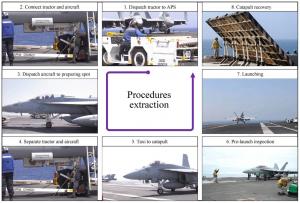GA, UNITED STATES, February 21, 2025 /EINPresswire.com/ — This paper addresses autonomous sortie scheduling for carrier aircraft under towing mode, transforming it into a hybrid flow-shop scheduling problem (HFSP). A chaos-initialized genetic algorithm (CiGA) is developed, integrating delayed strategies for collision avoidance. Numerical simulations validate the model’s efficiency, showing improved sortie efficiency and adaptability for various onboard support scenarios.
With the growing demands of modern naval warfare, efficiently and safely scheduling more carrier aircraft within the limited deck space has become crucial. To that end, Associate Professor Xinwei Wang's team from Dalian University of Technology conducted a study on autonomous sortie scheduling for carrier aircraft fleet under towing mode.
“To address multi-source coupled constraint scheduling problem, that is, allocation of limited supporting resources and collision-avoidance between heterogeneous dispatch entities,” Wang explains. “We proposed a novel scheduling model that abstracts the entire sortie process into a hybrid flow-shop scheduling problem (HFSP), taking into account task priorities, dispatch coordination, and resource constraints.”
The solution framework was validated in a simulation environment based on the Ford-class carrier, and the results show that it can significantly improve the sortie efficiency of carrier aircraft compared to existing strategies.
The team published their study in the KeAi journal Defence Technology, with animation of the simulation results available here.
Specifically, the solution involves:
abstracting the entire sortie process into eight key processing procedures, and treating tractors, preparing spots, catapults, and launching as "machines";
constructing a mixed-integer programming model by thoroughly analyzing the constraints of sortie scheduling, particularly optimizing the constraint on preparing spot occupancy to further improve sortie efficiency; and
establishing basic trajectory libraries for each dispatch entity and introducing a delay strategy to solve collision-avoidance issues; designing a Chaos-initialized Genetic Algorithm (CiGA).
“Going forward, our focus will be on implementing the proposed spatiotemporal coordination method in the simultaneous sortie and recovery scenario, and developing GP-based solution algorithms tailored for this specific context,” adds Wang.
DOI
10.1016/j.dt.2024.07.011
Original Source URL
https://doi.org/10.1016/j.dt.2024.07.011
Funding information
The authors are thankful to the financial support of the National Key Research and Development Plan (2021YFB3302501); the financial support of the National Natural Science Foundation of China (12102077).
Lucy Wang
BioDesign Research
email us here
Legal Disclaimer:
EIN Presswire provides this news content “as is” without warranty of any kind. We do not accept any responsibility or liability
for the accuracy, content, images, videos, licenses, completeness, legality, or reliability of the information contained in this
article. If you have any complaints or copyright issues related to this article, kindly contact the author above.
![]()

